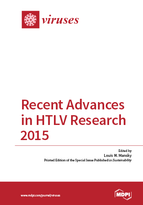Recent Advances in HTLV Research 2015
A special issue of Viruses (ISSN 1999-4915). This special issue belongs to the section "Animal Viruses".
Deadline for manuscript submissions: closed (1 October 2015) | Viewed by 155379
Special Issue Editor
Interests: human retroviruses; virus assembly; reverse transcription; retroviral diversity and evolution; antiretroviral
Special Issues, Collections and Topics in MDPI journals
Special Issue Information
Dear Colleagues,
The human cancer-causing retroviruses—i.e., human T-cell leukemia virus types 1 and 2 (HTLV-1 and HTLV-2)—were both discovered over three decades ago. About 14 million people are infected with HTLV-1 and many millions with HTLV-2 worldwide. HTLV-1 is associated with the T-lymphocytic malignancy called adult T-cell leukemia/lymphoma (ATLL) in about 2 percent of individuals infected, and another 2 to 3 percent of individuals develop a neurologic disorder called HTLV-associated myelopathy (HAM). HTLV-2 causes HAM in approximately 1 to 2 percent of infected individuals, but does not cause ATLL. HTLV-1 and HTLV-2 have served as excellent models for the study of the epidemiology and pathogenesis of virus-associated cancers as well as autoimmune conditions such as multiple sclerosis. Recently, two new members—HTLV-3 and HTLV-4—have been discovered in bushmeat hunters from central Africa, which emphasizes the urgent need for continual surveillance for new human retroviruses and their capacity to cause disease.
The viral oncoprotein Tax-1 is encoded by HTLV-1 and is both necessary and sufficient for viral transformation, and Tax-2 is encoded by HTLV-2 and in animal models does not induce tumors. The HTLVs encode for other regulatory proteins, including the HTLV-1 basic leucine zipper factor (HBZ), which inhibits Tax-mediated gene expression and is encoded as an anti-sense viral transcript. The HTLV-1 p30II protein can act as an agonist of Tax-mediated transcription and serves as a multifunctional repressor of cellular gene expression.
Leukemogenesis mediated by HTLV-1 remains an intensive area of investigation. The focus of current research remains on the Tax effects on cellular transformation, the consequences of perturbing cell cycle control and genome stability, the role of HBZ and p30II on viral pathogenesis, HTLV-1 latency and reactivation, as well as therapeutic approaches. The study of HAM pathogenesis has great potential as a model for neuroimmunologic dieseases. New and exciting progress is being made in the basic understanding of viral replication of the HTLVs, particularly in virus assembly and particle structure.
Important public health issues remain open issues to be addressed in spite of the basic epidemiology of HTLV-1 and HTLV-2 being reasonably well defined—i.e., emergence patterns in new host populations, transmission prevention, improved blood donor screening, and potential human transmission of HTLV-3 and HTLV-4. Clinical research is needed in developing potential HTLV-1 and HTLV-2 vaccines, as well as development of treatment options for ATLL and HAM. This ‘recent advances issue’ contains both reviews and updates on research that encompasses these areas.
Prof. Louis M. Mansky
Guest Editor
Manuscript Submission Information
Manuscripts should be submitted online at www.mdpi.com by registering and logging in to this website. Once you are registered, click here to go to the submission form. Manuscripts can be submitted until the deadline. All submissions that pass pre-check are peer-reviewed. Accepted papers will be published continuously in the journal (as soon as accepted) and will be listed together on the special issue website. Research articles, review articles as well as short communications are invited. For planned papers, a title and short abstract (about 100 words) can be sent to the Editorial Office for announcement on this website.
Submitted manuscripts should not have been published previously, nor be under consideration for publication elsewhere (except conference proceedings papers). All manuscripts are thoroughly refereed through a single-blind peer-review process. A guide for authors and other relevant information for submission of manuscripts is available on the Instructions for Authors page. Viruses is an international peer-reviewed open access monthly journal published by MDPI.
Please visit the Instructions for Authors page before submitting a manuscript. The Article Processing Charge (APC) for publication in this open access journal is 2600 CHF (Swiss Francs). Submitted papers should be well formatted and use good English. Authors may use MDPI's English editing service prior to publication or during author revisions.
Keywords
- HTLV
- adult T-cell leukemia
- transformation
- leukemogenesis
- deltaretrovirus
- autoimmunity
- lymphoma







